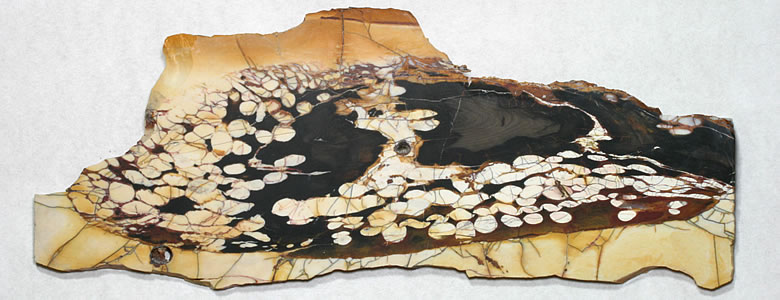
A nice slab of peanut wood showing lots of “peanut” markings that were produced by the infilling of boreholes made by clams. This slab is about 12 inches in width and was cut from peanut wood mined in the Kennedy Ranges of Western Australia.
Peanut wood is a variety of petrified wood that is usually dark brown to black in color. It is recognized by its white-to-cream-color markings that are ovoid in shape and about the size of a peanut. It received its name from these peanut-size markings. It is a fossil gem with a very unusual history.
How Does Peanut Wood Form?
Much of the peanut wood being sold today began its life as a conifer tree on land in the area now known as Western Australia. When these trees died, rivers carried them into a shallow, salty epicontinental sea that covered much of what is now the Australian continent.
They arrived at the sea as a piece of driftwood. This was during the Cretaceous time period, when a species of marine clam that loved to eat wood lived in the Australian sea. The clam larvae were able to smell nearby wood and swim to it. When they arrived at a piece of driftwood, they would attach themselves to it and start eating. A tiny pair of valves soon developed on one end of their long body, and they used the sharp edges of their shell as a rasp. They shaved off tiny particles of wood – which they would promptly eat. In a few weeks they could excavate a deep tunnel into the soft, mushy wood.
Shipworms!
A few species of these wood-eating clams live in the oceans today. Sailors have cursed about them for hundreds of years as the enemy of wooden ships. Sailors began calling them “shipworms” because of their long bodies and their ability to tunnel into a ship much like a worm tunnels through an apple. In the 1700s, shipbuilders began lining the hulls of their ships with thin sheets of copper to protect them from the shipworm. Shipworms have been ruining ships, pilings, docks, retaining walls, and other wooden structures as long as people have been placing them in salt water.
How the Peanuts Form
Back to the Cretaceous seafloor where the waterlogged wood that has been heavily drilled by prehistoric shipworms is resting. Billions of tiny radiolarians (tiny plankton with siliceous shells) are living in the water above the wood. A river mouth is a great place for radiolarians to live because the river delivers a continuous supply of nutrients to the sea. When the radiolarians die, their tiny silicious shells sink to the bottom and accumulate as a white sediment known as radiolarian ooze.
Layer after layer of radiolarian ooze accumulated over the wood, entered the bore holes, and some of it dissolved to form a super-saturated silica solution. This dissolved silica precipitated in the cavities of the wood and replaced the woody tissues, converting the waterlogged wood into a fossil.
Today, if a piece of the wood is broken, the petrified wood is a brown-to-black color. Contrasting with the wood is the white radiolarian ooze that filled the boreholes. Since the boreholes are filled, they appear on the broken surface of the wood as white oval-shaped markings about the size and shape of a peanut. That is how the peanut wood obtained its distinctive appearance and its name.
The sediments that contained the peanut wood lithified into sedimentary rocks that are now known as the “Windalia Radiolarite.” The Windalia was eventually uplifted as part of Western Australia’s Kennedy Ranges, which are now above sea level. A few lapidaries found the peanut wood, tried cutting it and discovered that it is a gem material that can be used to make very colorful, interesting, and brightly polished cabochons.
Soon, peanut wood was being used to make clock faces, spheres, beads, and many other lapidary products. Small leftover pieces from these projects can be loaded into a rock tumbler and used to make tumbled stones. The gem material is very attractive, and its unique appearance immediately grabs attention.
It is surprising that an ancient waterlogged wood that was bored by ship worms is now a popular gem that is cut, worn, displayed, and talked about all over the world.
Courtesy and From: Geology.com



 October 18th, 2015
October 18th, 2015  Riffin
Riffin  Posted in
Posted in  Tags:
Tags: 